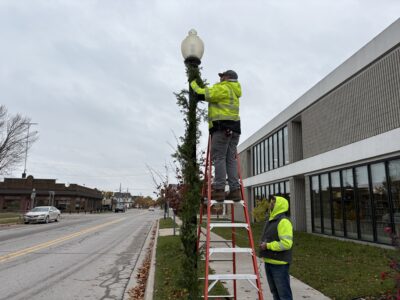Officials talk ice storm, extreme weather preparedness

News Photo by Steve Schulwitz Kristen Fairey, left, Cori Fitzpatrick, Jesse Osmer, and Rachel Smolinski speak on Tuesday about the March ice storm and the impact and cost it had on the area. They made the presentation during an Extreme Weather Emergency Tour stop in Alpena.
ALPENA — Northern Michigan residents learned firsthand the impacts and costs of severe weather events, like the ice storm that battered the area in late March.
For many years, large and dangerous weather events were associated with locations many miles from northern Michigan, but the ice storm opened the eyes of many and now there is an effort to prepare for any emergency weather events in the future and to secure more money to help the communities impacted by the storm recover.
On Tuesday at the Alpena County Library, the Extreme Weather Emergency Tour visited Alpena and during the stop, local officials, business people, and other experts talked about how the ice storm rattled the local economy, public safety, infrastructure, and public health as a whole.
The tour is paid for by the Climate Action Campaign, a group of environmental and sustainability organizations.
Alpena County Administrator Jesse Osmer opened the press conference by explaining the impacts left behind after the storm passed. He said it took days for the state and National Guard to respond, and local governments were left to deal with the evolving emergency by themselves and with the help of some partners.
“The storm left thousands of people without power and there were hundreds of downed power lines down in Alpena County and we were left to navigate all of this completely alone,” Osmer said. “The county’s and my personal Facebook pages became our town square and a way to get information out. They call these 100-year storms, but anyone with eyes can see that these types of events are happening with more frequency that should give us pause and inspire us to prepare.”
In order to prepare and make sure adequate shelters are available and improving the local infrastructure is easier said than done. Most local municipalities face tight finances or have budgets that are in the red. In order to better plan and improve infrastructure, and help reduce the financial stress on local governments from the cost of the storm’s response and cleanup, state and local governments should allocate money to help.
Alpena City Manager Rachel Smolinski said like Alpena County, the storm cost the city nearly $500,000 in unexpected expenses. She said although the area has bounced back well from the fallout from the storm, there is still more to do. Smolinski said being proactive now can help ease the pain when another emergency situation arises, no matter when that is.
“The storm was truly something unprecedented and who would have thought that when we all went home on that Friday, that by the next evening we would be looking out of our windows and realizing that we were truly in trouble and I don’t think any of us were fully prepared for it,” she said. “The storm caused a strain on our buildings, as well as our Department of Public Works, and EMS services. I think we can be much more resilient in the future and be better prepared, but we need support from our state and federal partners and bring more funding to our area. If something like this happens again, I think it is safe to say for three days we will be on our own before we see resources roll in. We learned that we won’t really see any other resources for about 72 hours. We want to be able to be prepared to stand this community up for at least that long.”
Cori Fitzpatrick, the farm to institution specialist for the Groundwork Center for Resilient Communities, said the agriculture community was also hit hard by the storm, which put some of this year’s crops in jeopardy and damaged critical infrastructure needed to plant, maintain, and harvest food.
She said the local food and farm economy is still suffering through financial challenges from the impacts of the storm, especially small farms. She said having federal partners is important, like the Federal Emergency Management Agency (FEMA) and the National Oceanic and Atmospheric Administration (NOAA), who can help plan and invest.
“These are farmers that are really committed to the local food economy and they are people who are producing nourishing food for schools, food pantries, medical centers, for a greater community alike,” Fitzpatrick said. “They saw significant damage to fences, irrigation systems, and other critical infrastructure. They lost product, seedlings, and early cold crops. We are still really in the beginning of the lasting effects. As extreme weather events continue to threaten Michiganders, it is imperative we have agencies like FEMA and NOAA to strengthen our preparedness.”
Kristen Fairey, owner of Birch Hill Grocery in Grand Lake, said the ice storm was not the first severe weather emergency in the area. She said several years ago, a storm that produced a powerful tornado in Gaylord in 2022 dumped large hail in the area of Presque Isle. She said there was a lot of damage to people’s homes, automobiles, and some of the damage is just now being fixed and residents are now paying more to insure their property.
“The hail storm was more isolated than the ice storm, but it dropped baseball-sized hail. It was definitely extreme, nobody expected to get hail of that size, and now, insurance costs have surged for some people’s homes, and all of this is completely the result of rising temperatures, Fairey said “I think from my standpoint, it is important to recognize we genuinely have a problem and it needs to be addressed.”
Alpena is one of six stops on the tour, with the others being in Atlanta, Ga., which has suffered from extreme heat, Easton, Penn., which had heavy rain and flooding, Pittsburgh, which also had extreme rain, and Phoenix, which has record heat, and Yuma County, Az. which is crippled with extreme drought.
Steve Schulwitz can be reached at 989-358-5689 or sschulwitz@TheAlpenaNews.com. Follow him on X @ss_alpenanews.com.






